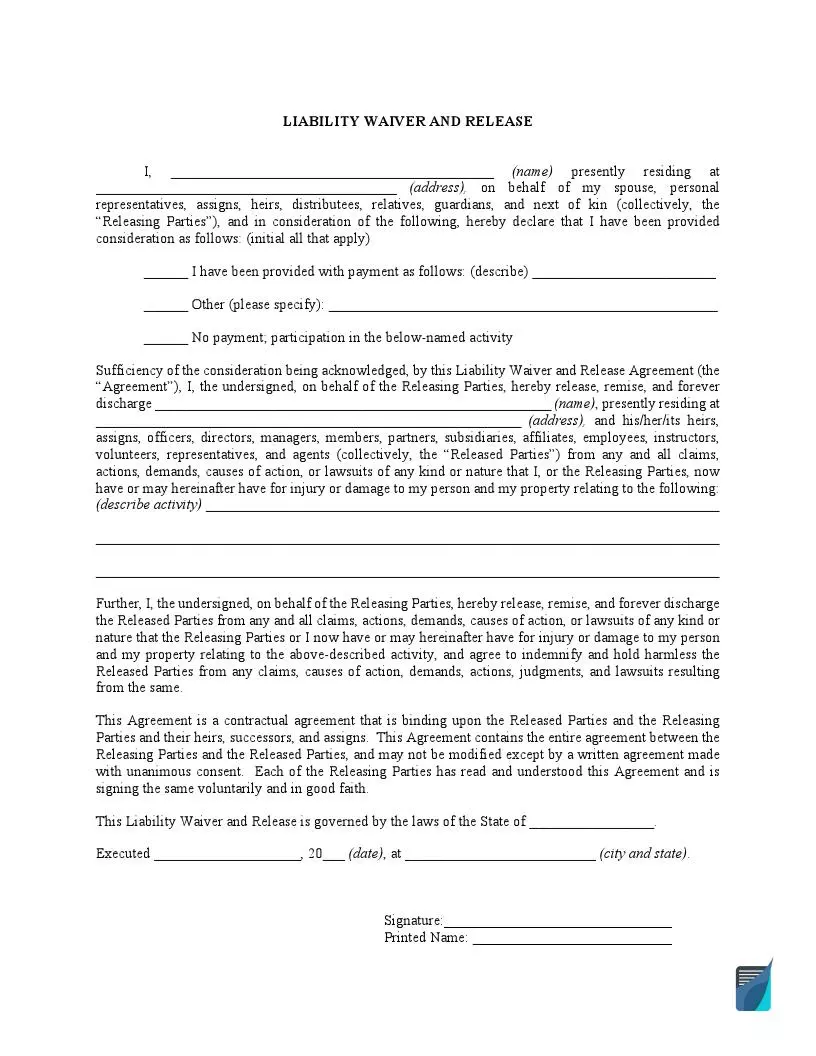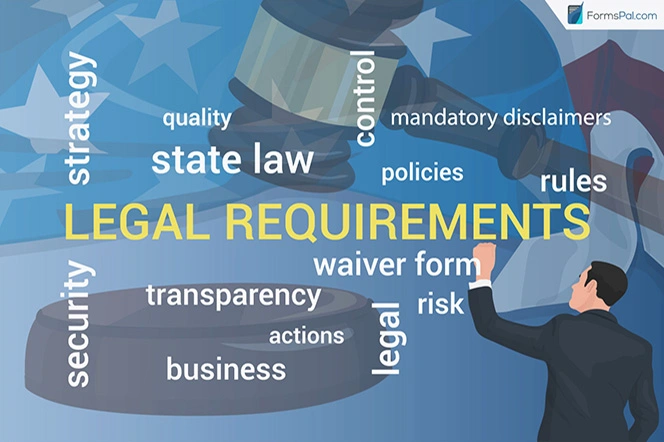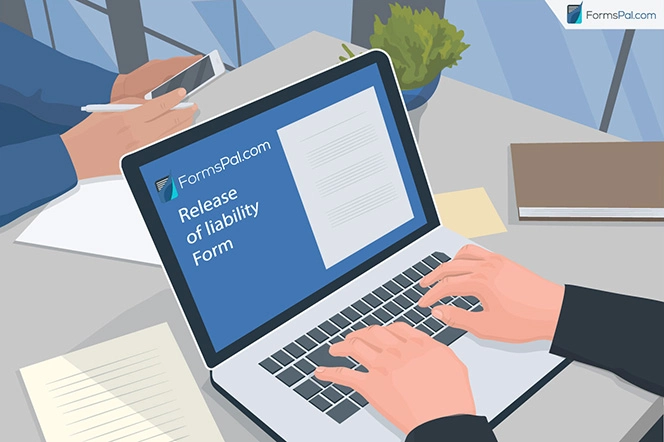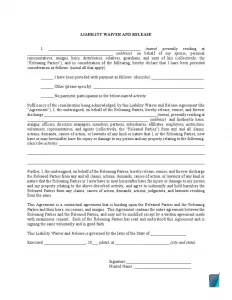Release of Liability Form
A Release of Liability Form is an agreement between two parties where one party promises not to sue or take legal action against another party for a past or future potential legal claim.
It is a legal document signed between a “Releasor” and a “Releasee.” A releasor is the one who has or may have a potential claim under the law, but he or she promises not to sue the other party. A releasee is the one who the releasor promises to hold harmless and not sue. Once signed by both parties, the release form shows that the releasor acknowledges the associated risks and legal claims they might have and agrees to not take recourse under the law against the release.
A release of liability form might also be called a hold harmless agreement or a waiver of liability.

Build Your Document
Answer a few simple questions to make your document in minutes
Save and Print
Save progress and finish on any device, download and print anytime
Sign and Use
Your valid, lawyer-approved document is ready
When to Use?
The waiver of liability can be used for both past and future events. When an event that potentially warrants a lawsuit has already occurred, then the parties may decide to settle the dispute among themselves rather than going for an expensive court case and hiring a lawyer. Sometimes, when the parties are about to engage in an activity that has some inherent risk, then before beginning such activity, one party can ask for a liability waiver from the other. The release form conveys the message of “proceed at your own risk.” By signing the agreement, the party who has suffered physical harm or is at the risk of suffering physical harm agrees to a waiver of legal rights to take action.
Past Events
Events such as car accidents, accidents causing physical harm, personal injury accidents, and actions causing property damage to another individual may lead to lawsuits against the party at fault for damages or compensation. In such cases, the parties involved can choose to settle the dispute out of court by signing a liability waiver agreement.
The party who sustained injuries or suffered property damage can agree to a liability release of the defaulting party in return for a settlement amount that can be mutually decided by the two parties involved. The compensation can be decided based on the estimated costs of medical bills, damage repair charges, missed days of work due to the injury, or costs of other damages involved. This way, by agreeing to not file a claim in a court and signing a release agreement, the parties can save costs of litigation or lawyer fees.
You can use a release of liability form if:
- You caused a physical injury to someone and you want to settle the matter out of court to save court expenses and lawyer fees.
- You suffered physical injuries due to another person’s fault and you don’t want to spend time and money on court and lawyer expenses.
Future Events
It is always a good idea to use a release agreement before a potential legal risk can arise. It can include all events, products, or services that can physically harm the participant or user. Events or activities involving risks such as adventure sports, athletic events, sports league, paintball, or experiments related to a new product testing can sometimes lead to injuries to a participant or attendee and he or she may take legal action against the organization or corporation holding the event or activity. The organizers can use a release of liability form for protection against legal claims that may arise due to an accident or personal injury.
Similarly, a particular product or service may not be suitable for a specific age group, minor, or an individual with specific health concerns. The service or product providers can use release of liability forms to save themselves from legal claims. For example, a gym owner can use this release form for protection against injuries arising due to specific health conditions.
You can use a liability waiver form if:
- If you are holding, organizing, or providing an activity, product, or service that involves risks of causing physical harm or injuries.
- You are hiring an employee for a physically taxing job.
Limitations of Using a Release of Liability
It is crucial to note here that a release of liability agreement is a “civil arrangement” between the parties signing it. It only provides protection against civil liability which is limited to monetary compensation. It does not protect the releasor against criminal liability that can arise due to gross negligence or reckless disregard of safety. A waiver form cannot be used to get rid of one’s legal responsibility to exercise reasonable care and caution. For example, if an event organizer uses faulty equipment, whether knowingly or unknowingly, and damage or harm is caused due to it, he or she can still be held responsible for the damage. Similarly, selling products without following product safety requirements under the law will not be protected under liability waivers.
Main Types of Release
The most commonly used types of releases are:
- General Release: When broad waivers are being given regarding all known and unknown claims that may arise and the releasor agrees to forego all known and unknown legal rights, a general release is used. A general release is flexible and customizable to include almost all types of disputes.
- Car Accident Release: It is used for automobile accidents where parties mutually settle the dispute between themselves and the party at fault gives monetary compensation in return for releases from legal claims.
- Mutual Release: As opposed to a general release, this type of release includes releases from both parties. It is most commonly used in disputes arising from broken contracts where each party believes it is the other’s fault. Instead of opting for long and costly legal battles, they settle the matter by releasing each other from certain liabilities.
- Property Damage Waivers: When there are chances of damage to property or when the damage has already occurred, then a property damage waiver is signed. For example, while renting a car, the renting agency may require you to sign this waiver to hold it harmless against damage to the car, traffic rule violations, or an accident by requiring you to make a deposit beforehand. If damage has already happened, parties may agree to settlement money for waiving legal claims.
- Activities Waivers: These are commonly used waivers for participation in activities that are inherently dangerous and may lead to physical or psychological injuries. These can include river rafting, bungee jumping, sky diving, or paragliding. It is important to keep in mind here that such waivers do not save the event organizer from acts of gross negligence and it is still required to take all reasonable care and safety precautions.
Getting a Release of Liability
The process of getting a release of liability is easy and does not necessarily require legal representation. There are a wide variety of situations in which people can use it and as a result, it is important to carefully customize the release of liability based on individual circumstances. For example, a release of liability for a past car accident will be completely different from a release of liability for a car sale. Therefore, putting in the proper information is crucial while preparing a release document. Here are some simple steps to guide you on how to prepare a release of liability documents easily:
Determine the Risks Associated With the Event

Each event has a different risk associated with itself. For example, rock climbing has associated dangers of bodily injuries, while skin product testing has associated dangers of allergies. Identification of the danger or harm involved helps in writing better terms and clauses related to protection in the release contract.
Determine the Legal Requirements

If the release of liability form is mandatory under the state laws, then each state may have different requirements for such release form. It is important to draft the documents in accordance with the state law for them to be valid. For example, Florida has recommended “Lien Waiver Forms” related to construction projects. California has mandatory liability waiver documents for the sale of a used vehicle.
Draft the Release of Liability Form

Once you have identified the dangers involved and legal requirements, draft the release form with all the required details and information such as party name, date, and event description. If there are mandatory clauses required under the state law, include them as well. If the waiver is for a settlement, then terms like the settlement amount and degree of release should be mutually discussed between the parties.
Execute and Sign

Once the form is drafted with all the requisite details and information, it should be given to the other party before the event takes place if it is for future activity. It should contain the signature of both parties. The form should be clear and neatly printed.
Consequences of Not Using the Form
If you don’t sign a release of liability, you can open yourself to the risk of unnecessary litigation. Even though it might take some time and effort to create this legal document, yet it is worth it as it provides an extra layer of protection to individuals involved in risky activities or dealing with risky products or services.
Releasor’s Perspective
From the perspective of a releasor, the waiver form alerts an individual about to indulge in a risky incident about the dangers involved and the potential damages that can arise. It also saves a releasor from the time, effort, and expenses spent for a lawyer and a court case. Further, sometimes participants can equally be at fault for not following the prescribed safety procedure. In such a situation, a liability release provides you with reasonable compensation when you decide to settle the dispute outside the courts.
Releasee’s Perspective
From the perspective of a releasee, it is critical to use release of liability forms to avoid one-sided responsibility. An organizer or contractor dealing with risky activities can be held liable for civil claims, even if he or she is not reasonably responsible for the incident. Having a liability release form in place reduces the possibility of legal action by providing a warning about the participation risks. The “burden of proof” shifts upon the customers or participants to prove that they were not warned about the risk involved in the situation.
What Should be Included?
A release of liability form should include the following provisions:
- Releasor and Releasee: Name, address, and contact information of the releasor and releasee.
- Consideration: If the release includes a settlement amount or is a result of a transaction, then enter the amount agreed to between the parties.
- Cause of Release: Specify the name, time, and place of the activity for which the release is being signed such as a car accident, a real estate transaction, or a skydiving session.
- Effective Date: This is the date from which the waivers take effect. It is usually before the event happens.
- Inherent Dangers Involved: Give a brief description of the inherent dangers involved in the activity such as physical harm or even death in some extreme sports like a bull race.
- Liabilities Covered: This clause should mention what liabilities are covered. It can include liability coverage against court cases or payment of medical bills.
- Governing State: The state whose laws will govern the dispute between the parties.
Additionally, the form may also include the following terms:
- Insurance: The releasee bears no responsibility for individual medical, car, or life insurance.
- Medical Treatment: If medical treatment is provided at the venue of the event by the organization, the participant cannot sue for further injury due to medical treatment.
- Modifications: Modifications to the contract must be in writing.
- Severability: Even if a part of the agreement is invalid, the rest of it will still be valid.
- Attorney Consultation: That each party has had the opportunity to consult an attorney before signing and they are putting the signature from their own free will.
- Assumption of Risk: That the participant understands and agrees to the dangers involved in the activity and still chooses to move forward with it.
Release of Liability Form Details
| Document Name | Release of Liability Form |
| Other Name | Liability Waiver |
| Avg. Time to Fill Out | 10 minutes |
| # of Fillable Fields | 18 |
| Available Formats | Adobe PDF |

Filling Out a Release of Liability Form
After reading and understanding the above-mentioned information, you can easily use fill liability waiver templates by yourself. The below-mentioned steps will guide you in filling out FormsPal’s free release of liability form:
Enter Releasor Information
Enter the full name and address of the releasor including the residential address, city, and state in the first paragraph.

Enter Considerations
Enter the amount of consideration being provided to the releasee to sign the contract. Write the payment money in both words and numbers and mention the currency. If there is an additional payment, then mention that in the second line. If no payment is being made, then choose the third option and write “NIL” in the above-mentioned options.

Enter Releasee Information
Write the full name and address of the releasee including the residential address, city, and state after the words “forever discharge.”

Describe the Event or Activity
Enter all information about the event activity for which the waiver is being provided including the name, date, place, and time, if applicable.
For example, if the waiver is for a past car accident, then write, “the car accident that happened on November 26, 2020, at 6th Avenue Street in New York City at 5:30 pm and caused bodily injuries to the releasor.”
If the waiver is for a skydiving session, then write, “the skydiving session that will be conducted on December 20, 2020, in Alaska by ABC corporation.”

When you sell a vehicle, the legal formalities to transfer a vehicle may take some time even after the sale and purchase transaction is completed. Until the title and registration is transferred in accordance with state laws, you still remain the owner of the car. If the car hits someone, you can be legally held liable for the accident. Therefore, a liability waiver is required to protect the seller against the risk of potential car accidents or parking traffic violations. Some states such as California require a mandatory release or waiver while the DMV processes the transfer. Even if not mandated under the state law, it is preferable to have a liability release or waiver in place. The waiver should include crucial details such as the odometer reading, vehicle identification number, and the date of sale. Different states may have different sample release forms. To see an example notice of transfer and release of liability, visit the California DMV website. A parental waiver is a release of liability signed by parents on behalf of their minor children. A liability release is a contract under law. Since contracts by minors are not valid, liability waivers signed by minors are also not valid. When minors are involved in a risky activity such as recreation events, a liability release signed by their parent or guardians is required. For example, school trips may require parental waivers. Yes, you can create a legally valid release of liability online. After understanding its simple requirements described above, you can easily create this form by following the simple steps described above. Release of liability forms created online are perfectly valid under law and can be created at your own ease without spending unnecessary time and money.Frequently Asked Questions
Do I Have to Use it During a Vehicle Sale?
What is Parental Waiver?
Can I Create This Form Online?
You can use FormsPal’s free release of liability form, which is fillable and easy to use. You can also try creating the form with our simple document builder that will guide you through the process step-by-step.